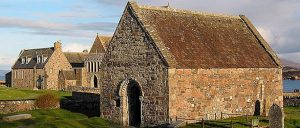Argyll & Bute
Iona
This small island, a mile off the south-west corner of Mull became the focus of early celtic Christianity when St Columba and twelve companions were exiled from Ireland in 563 following a tribal feud. They set up a monastic community devoted to preaching the gospel both by word and deed to the surrounding pagan tribes. Small groups of monks moved around Scotland, practising what they preached, gradually establishing Christian communities in many places. St Columba's Bay, on the south of the island, is the traditional site of his arrival.

Iona Abbey
Columba died at about the time that St Augustine arrived in England in 597, sent from Rome by Pope Gregory, as an emissary to King Ethelbert of Kent. When Ethelbert's daughter married King Edwin of Northumbria, the scene was set for the two-pronged spread of the gospel throughout England in the seventh century. In 635, Edwin's successor, King Oswald, sent to Iona for monks to lead the young Northumbrian church. There were few volunteers, but in due course Aidan came forward and set up his headquarters on the island of Lindisfarne.
Iona, like Lindisfarne, was a centre for the production of richly illustrated Gospel manuscripts. It is believed that the famous Book of Kells was produced here. Columba's monastery was destroyed by the Viking raids of the ninth century, the monks fleeing to Ireland, where their beautiful book can be seen in Dublin.
The present Iona Abbey buildings date from the early thirteenth century, but they fell into disrepair after the Reformation. In 1899, the Duke of Argyll presented the site to the Iona Cathedral Trust. In 1938, the Iona Community was founded by George Macleod as a centre for retreat and reflection, with an emphasis on how the values and culture of the early Celtic church can be applied to the modern world.


